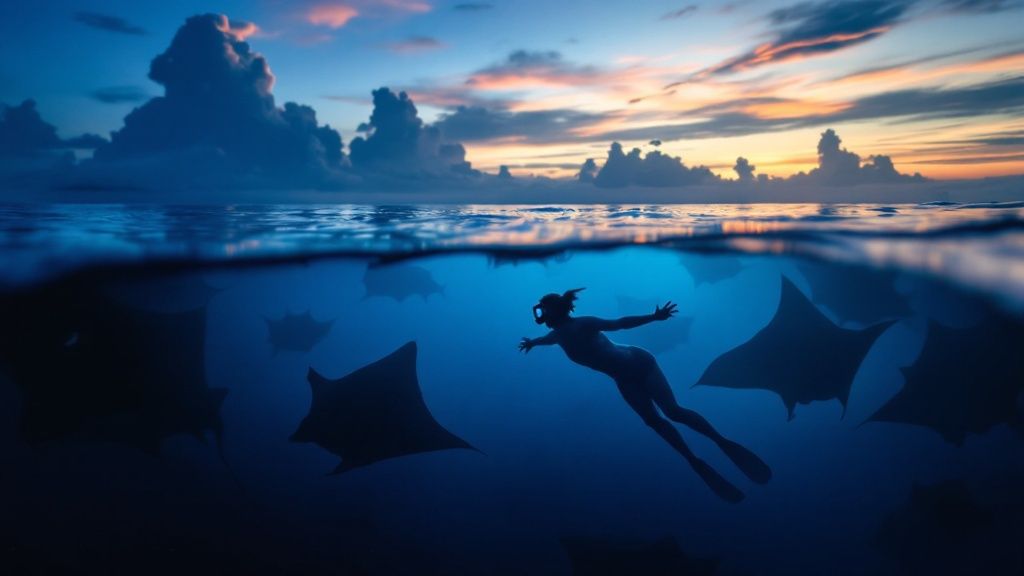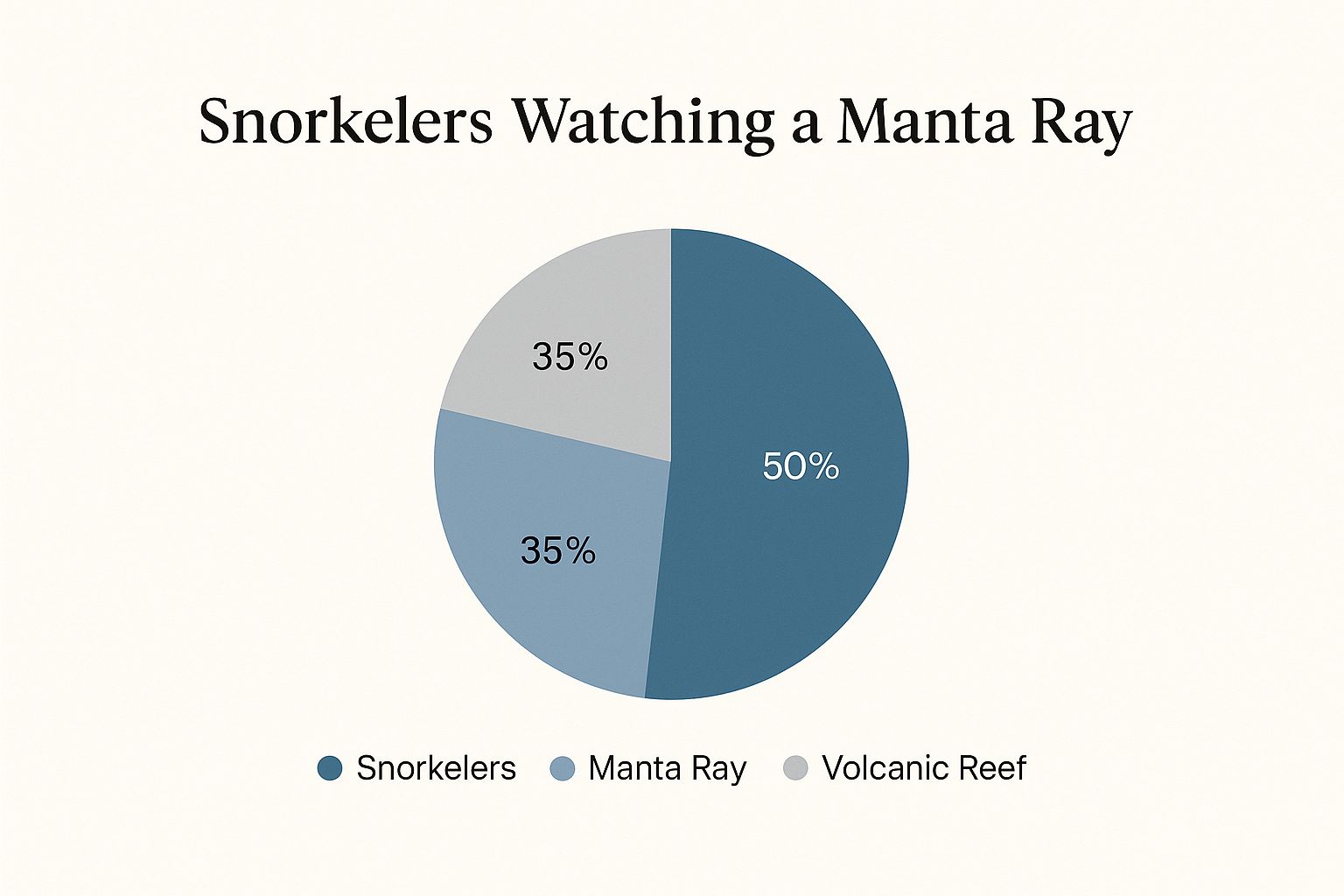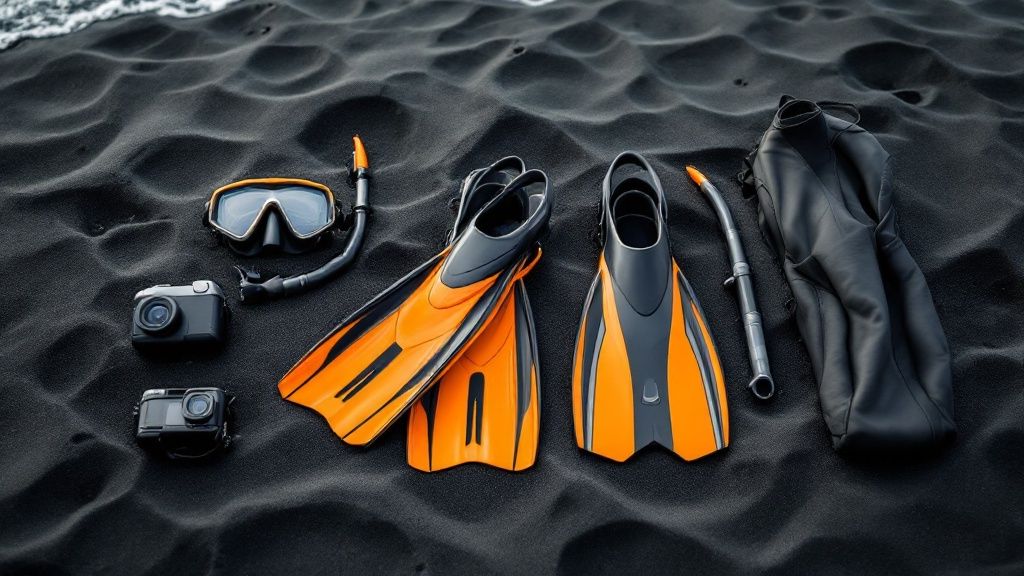Manta Ray Snorkeling Big Island | Experience Underwater Magic

The Magic of Manta Ray Snorkeling Big Island

Manta ray night snorkeling off the Big Island is an unforgettable experience. Many visitors consider it a highlight of their time in Hawaii. It's more than just a typical tourist activity; it's a chance to connect with these graceful giants of the deep.
What makes this experience so exceptional? It's the unique combination of several factors. The presence of bioluminescent plankton is essential. These tiny organisms create a dazzling underwater display that attracts manta rays, who feed on them.
The plankton thrive in nutrient-rich waters. The Kona Coast, with its volcanic slopes and distinctive underwater landscape, provides the perfect environment.
This consistent food supply brings mantas back to the same areas night after night. This predictability contributes to a high success rate for manta ray sightings. Kona Coast manta ray snorkeling boasts an impressive 85-90% sighting success rate.
Operators like Jack's Diving Locker have tracked individual manta rays. Data from 2009-2014 shows these creatures' consistent presence, further enhancing viewing predictability. For more information and detailed statistics, check out Jack's Diving Locker Manta Ray Report.
Dedicated conservation efforts also play a crucial role in protecting these magnificent creatures and their habitat. Organizations like the Manta Pacific Research Foundation tirelessly study manta ray behavior and advocate for responsible tourism. Their work ensures the manta ray population continues to flourish for future generations.
Why Choose Kona for Manta Ray Snorkeling?
Kona has become a central hub for manta ray snorkeling, with several tour operators providing outstanding excursions. Reputable companies like Kona Honu Divers, Manta Ray Night Snorkel Hawaii, Kona Snorkel Trips, and Captain Cook Snorkeling Tours prioritize safety, responsible viewing, and educational experiences.
Knowledgeable guides share insights about the manta rays and the marine ecosystem. This makes the experience both thrilling and informative.
The consistent sightings, combined with dedicated conservation efforts and professional tour operators, make the Big Island a top spot for manta ray snorkeling. It's a unique chance to witness nature's wonders, deepen your appreciation for marine life, and make memories to last a lifetime.
Premier Manta Ray Viewing Locations Around Kona

Not all manta ray viewing locations are created equal. The Big Island offers a few distinct spots, each with its own unique charm and characteristics. Knowing what sets these locations apart can help you select the perfect manta ray snorkeling experience on the Big Island.
Manta Village (Keauhou Bay)
Manta Village, nestled in Keauhou Bay, is famous for its unique lava tube formations. These formations create a shallow, protected area ideal for plankton to flourish. This natural buffet attracts manta rays, making it a consistently rewarding viewing spot. The generally calm waters of Keauhou Bay also make this an excellent location for beginner snorkelers.
Manta Heaven (Garden Eel Cove)
Manta Heaven, situated near Garden Eel Cove, truly lives up to its name. This site is celebrated for the impressive number of manta rays that congregate there. The open ocean setting can occasionally bring slightly more challenging conditions than Keauhou Bay. However, the potential for unforgettable encounters with larger groups of mantas often appeals to more seasoned snorkelers.
Other Viewing Opportunities
While Manta Village and Manta Heaven are the most frequented sites, other locations along the Kona coast can offer amazing viewing opportunities, depending on ocean conditions. Local tour operators continually monitor various sites, sometimes venturing further north or south along the coast, always seeking optimal viewing conditions. Certain areas may briefly become plankton hotspots because of shifting current patterns or seasonal changes. These temporary feeding grounds can result in exceptional and less crowded viewing for those adventurers open to exploring. For more information, check out our Kona Snorkel Trips Sitemap.
While precise population counts aren't readily accessible, research points to thriving manta ray populations at these viewing locations. Identification projects using photo databases, such as those maintained by Manta Ray Advocates, reveal dozens of regularly sighted individuals. Furthermore, annual reviews from 2011-2013 documented these stable returning populations, with some key individual mantas appearing hundreds of times over several years. This ongoing presence contributes to the remarkable 85-90% encounter rate cited by tour operators. This data also revealed site fidelity: a fascinating behavior where many mantas consistently favor either Garden Eel Cove or Keauhou Bay, a factor that influences operators’ nightly site choices.
The data chart below compares key features of Manta Village and Manta Heaven to help you choose the best site for your experience level.
| Location | Success Rate | Access Method | Average Group Size | Best Season | Experience Level |
|---|---|---|---|---|---|
| Manta Village (Keauhou Bay) | 85-90% | Shore/Boat | 10-20 | Year-round | Beginner – Intermediate |
| Manta Heaven (Garden Eel Cove) | 85-90% | Boat | 10-30 | Year-round | Intermediate – Advanced |
This table summarizes key information about the two main manta ray viewing locations, highlighting their distinct characteristics and helping snorkelers select the site best suited for their skill level. Manta Village provides easier access and calmer conditions ideal for beginners, while Manta Heaven offers the potential for larger manta ray encounters for more experienced snorkelers.
Selecting Your Perfect Manta Ray Encounter Experience
Choosing the right manta ray snorkeling tour on the Big Island is crucial for an unforgettable experience. With a variety of operators, considering key factors beforehand ensures a magical encounter with these gentle giants.
Group Size and Boat Type
Tour operators offer diverse boat sizes, each having unique advantages. Smaller boats, holding around six people, offer a more intimate, personalized experience. You'll have more chances to chat with your guide and fellow snorkelers. Plus, smaller boats can often access less crowded viewing areas.
Larger vessels, accommodating over twenty guests, provide more stability and amenities, such as restrooms and changing areas. This is key if you're prone to seasickness or prefer extra comfort. The ideal choice depends on your personal preferences.
Guide Expertise and Safety
A knowledgeable guide enriches the manta ray snorkeling experience. Seek operators with certified naturalists or marine biologists. They offer invaluable insights into manta ray behavior, biology, and the ecosystem.
Prioritize operators emphasizing safety, including thorough pre-snorkel briefings, proper safety equipment, and experienced crew in the water. Safety should always be paramount.
Equipment Quality and Sustainability
High-quality snorkeling equipment directly impacts your enjoyment. Ensure the operator provides well-maintained masks, snorkels, fins, and wetsuits. Comfortable gear lets you focus on the manta rays.
Consider the operator's sustainability practices. Opt for companies committed to responsible tourism, adhering to eco-friendly guidelines, minimizing environmental impact, and supporting manta ray conservation. This helps protect these creatures and their habitat.
Questions to Ask Before Booking
Before booking, ask a few key questions: What's the average group size? What's the cancellation policy for bad weather? Are food and drinks included? These practical details can greatly affect your experience. Also, inquire about the operator’s experience and success rate with manta ray sightings. Research and asking the right questions ensures you’re well-prepared.
To help you compare options, here's a table summarizing some popular tour providers:
To help you compare options, here's a table summarizing some popular tour providers:
Top Manta Ray Snorkeling Tour Operators
Comparison of leading tour operators offering manta ray snorkeling experiences on the Big Island
| Tour Operator | Group Size | Tour Duration | Price Range | Equipment Quality | Special Features |
|---|---|---|---|---|---|
| Kona Honu Divers | Varies | Varies | Contact for pricing | High | Private charters available |
| Manta Ray Night Snorkel Hawaii | Varies | ~2-3 hours | Contact for pricing | High | Focus on small groups |
| Kona Snorkel Trips | Varies | ~2-3 hours | Contact for pricing | High | Morning and moonlight tours |
| Captain Cook Snorkeling Tours | Varies | ~2-3 hours | Contact for pricing | Contact for details | Combine with Kealakekua Bay snorkeling |
This table provides a starting point for your research. Be sure to visit each operator's website for the most up-to-date information.
By considering these factors, you can select the perfect operator for your preferences, ensuring a truly memorable manta ray snorkeling adventure on the Big Island.
The Fascinating World of Hawaiian Manta Rays

Snorkeling with manta rays off the Big Island is an unforgettable experience. But beyond the visual spectacle, there's a deeper story of these animals and their lives in Hawaiian waters. These graceful creatures have fascinated researchers for years, and we’re still learning about their intelligence and complex behaviors.
Feeding Habits and Social Connections
Manta rays are filter feeders, using their cephalic fins to channel plankton-rich water into their mouths. This specialized adaptation allows them to thrive in the nutrient-rich currents around the Big Island.
Beyond feeding, mantas also display complex social interactions. They often gather in loose groups, particularly when feeding, creating an incredible sight for anyone lucky enough to witness it.
These gentle giants are surprisingly adept at navigating their ocean environment. They use a combination of fin movements, body positioning, and even color changes to communicate, showcasing their intricate understanding of the underwater world. For more related content, check out our sitemap.
Tracking and Migration Patterns
Scientists employ sophisticated tracking technology to monitor individual manta rays as they move throughout the Hawaiian islands. This research has uncovered surprising migration patterns, challenging previous assumptions.
For instance, in 2020, a tagged manta ray named Loulou swam an impressive 42 miles along the Hawaiian coastline over 8 weeks. Other tracked mantas, like Jolene, covered that same distance in a mere 8 days. You can learn more about manta ray movement patterns. This new data has reshaped our understanding of reef manta ray ranges, once thought to be limited to 30-mile territories.
Further demonstrating their complex movements, a manta named Vitor Ray reappeared in 2019 after a 17-month absence. This highlights the long-term cycles these animals follow. Even experienced tour operators account for these unpredictable patterns, understanding that an “off night” might just mean the mantas have ventured further afield in search of food.
Evolutionary Adaptations and Conservation
Manta rays possess a remarkably high brain-to-body ratio, one of the highest among all fish species. This emphasizes their significant cognitive capacity. Their adaptations for night feeding are also quite remarkable.
Unfortunately, these majestic creatures face ongoing conservation concerns. Understanding these challenges helps transform a Big Island manta ray snorkel trip from a simple sightseeing activity into a deeper appreciation for one of the ocean’s most extraordinary inhabitants.
Your Night Snorkeling Journey From Shore to Spectacle
Getting ready for a manta ray night snorkel is an exciting experience. This guide will walk you through a typical manta ray snorkel adventure, from the initial preparations to that amazing moment you first encounter a manta ray.
Preparing For Your Adventure
Most tours start with a check-in and safety briefing either on the shore or on the boat. Guides, such as those at Kona Snorkel Trips, will cover important safety procedures. They'll explain how to use the provided equipment and what to expect once you’re in the water. This briefing helps ensure a fun and safe experience for everyone.
Next, the boat heads out to the chosen manta ray viewing spot. The captain, using their expertise on ocean conditions and plankton density, will decide whether to head to Manta Village near Keauhou Bay or Manta Heaven off Garden Eel Cove. They might choose Manta Village for its calmer waters, which are ideal for less experienced snorkelers.
Entering The Water and The "Campfire Effect"
Once you’ve arrived at the site, the crew will lower powerful lights into the water. These lights create the "campfire effect," drawing in plankton, which in turn attracts the manta rays. Guides will then help guests enter the water, providing instructions on holding onto the floatation devices. This keeps the group together and offers a stable platform for watching the mantas.
This is where the magic happens. The lights illuminate the water, revealing the graceful forms of manta rays gliding below. Their wingspans, sometimes reaching a remarkable 16 feet, cast stunning silhouettes against the backdrop of the lights. Guides expertly position snorkelers for the best possible views.
Witnessing Manta Ray Behaviors
From your floating vantage point, you'll have the opportunity to see various manta ray behaviors. You might see them performing barrel rolls as they feed on the plankton. Their cephalic fins funnel these tiny organisms into their mouths. Sometimes, you’ll witness chain feeding, where multiple manta rays follow one another in a line, creating a truly captivating sight.
You might also see social interactions between manta rays, such as playful chases or gentle bumps. And, if you're lucky, you may even see a rare manta ray backflip – an impressive acrobatic display.
Addressing Night Snorkeling Anxieties
It's common for first-time night snorkelers to feel a bit anxious about being in the dark ocean. However, experienced operators like Captain Cook Snorkeling Tours and Kona Honu Divers focus on providing a safe and comfortable experience. Guides are always in the water, offering reassurance and assistance.
The bright lights and the presence of other snorkelers also create a sense of security, easing any worries about the darkness. This lets you focus on the incredible experience unfolding before your eyes. For more information on manta ray night snorkeling tours, check out Manta Ray Night Snorkel Hawaii.
Insider Tips for an Extraordinary Manta Experience
Want to transform your manta ray snorkeling trip from good to unforgettable? A little preparation and insider knowledge can go a long way. This means thinking about the whole experience, not just the basics. We've gathered tips from experienced boat captains, marine biologists, and seasoned manta ray snorkelers to help you make the most of your adventure.
Preparing For Optimal Viewing
Consider the moon phase when planning your trip. A darker night sky, like during a new moon, enhances the visibility of bioluminescent plankton. This creates a brighter, more attractive display for the manta rays. Also, keep seasonal patterns in mind. While mantas are present throughout the year, certain seasons may offer larger groups or different manta behaviors.
Even simple positioning techniques can improve your experience. Your guides will explain how to hold onto the floatation devices and angle your body for the best possible views. Staying still and minimizing splashing helps maintain clear visibility and respects the mantas' natural habitat. You might also be interested in our articles on how to improve your snorkeling technique: our articles on how to master snorkeling.
Ensuring Comfort and Capturing the Magic
Preparing for the ocean conditions is essential for a comfortable experience. Ocean temperatures can drop in the evenings, so consider dressing in layers before and after your snorkel. If you are prone to seasickness, taking precautions like ginger supplements or motion sickness medication beforehand can prevent discomfort.
Capturing the magic of your manta ray encounter is a must. If you are bringing an underwater camera, optimize your settings for low-light conditions. A higher ISO and slower shutter speed will help you capture the beauty of the manta rays in the dark water.
Respecting the Rays and the Environment
Responsible and sustainable tourism plays a crucial role in protecting these incredible creatures. Follow the etiquette guidelines provided by your guides, such as maintaining a respectful distance from the manta rays. Avoid touching them or any sudden movements that might disturb their natural behavior.
Choose tour operators that prioritize sustainable practices, such as Kona Snorkel Trips, Kona Honu Divers, Manta Ray Night Snorkel Hawaii, and Captain Cook Snorkeling Tours. Look for certifications or affiliations with conservation organizations as indicators of their commitment to protecting the marine ecosystem.
Post-Snorkel Traditions and Memories
After your snorkel, many tours offer warm drinks and snacks—a perfect way to warm up and reflect on the amazing experience. Sharing stories and photos with fellow snorkelers builds a sense of community and shared wonder. These post-snorkel traditions add to the overall memorable experience.
By following these insider tips, you’ll elevate your manta ray snorkeling adventure on the Big Island, creating a truly cherished memory and a deeper appreciation for the marine world.
Ready to embark on your own unforgettable manta ray adventure? Book your tour with Kona Snorkel Trips today! Experience the magic of manta rays with Kona Snorkel Trips!
